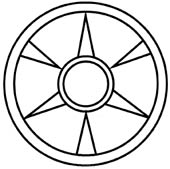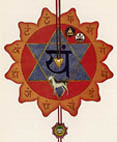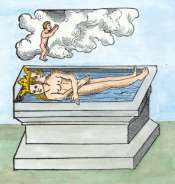3. The Alchemical Rosarium
Philosophorum
3.8 Summary and further conclusions
It
is now time to summarize the results so far and to draw some further
conclusions. I have shown that Carl Jung was convinced that behind
Sigmund Freud’s concretistic interpretation and the personal
psychology of sexuality, i.e., behind the personal intimate relationship
between man and woman, there must be a more universal aspect of this
primal drive, a (psychophysical) archetype, the so-called coniunctio
or Hierosgamos (Holy Wedding). Since Carl Jung was familiar with Gnosticism of
the first and the second century, he quotes the deep insight of the
Gnostics that “man’s
procreative power is only a special instance of the ‘procreative
nature of the Whole’.”
Thus, I postulate that we have to look for
a creation myth
on a deeper, psychophysical level, which fulfils these claims. We have
seen that it is
the Hermetic alchemical
Rosarium
Philosophorum, which could be the archaic myth we have to translate
into a modern language, taking into consideration the developments and
results of quantum physics as well as of Carl Jung’s depth psychology
of the 20th century. We have further seen that Carl Jung
interprets this archaic myth as the archetypal background of
the
transference/counter-transference problem
in psychotherapy. Therefore, a
first challenge arises: If I try to find an interpretation of the Rosarium
at a psychophysical level, it will include more than the archetypal
background of the above crucial problem of psychotherapy, and like this
it will perhaps
extend and/or contradict some of Carl Jung’s results,
the latter limited to the psychoanalytical setting.
The
alchemical myth, the Holy wedding or
conjunction – completely heretical when seen from a Christian
standpoint – tells us that a god and a goddess engage in sexual
intercourse and create a child.
Therefore, the Rosarium seems
to be the looked-for creation myth. It contradicts the Jewish/Christian
Genesis insofar as there is a divine couple and not God the Father alone
who creates the “new thing”. Further the sexual symbolism of this
compensatory creation myth is highly visible.
For Carl Jung the archetypal background of the
resulting third, of the new creation, is the child archetype. For him,
the archetypal child is the so-called tertium
non datur, the excluded third of Western philosophy and thus a
spiritual principle. With this interpretation the depth
psychologist limits the child archetype to what I will later call the
spirit-psyche and interprets it as “the
emergence of a new and as yet unknown [psychological] content,” “a
third thing of an irrational nature, which the conscious mind neither
expects nor understands.” Further, this “third thing of an
irrational nature”, which is unexpected and incomprehensible to the
consciousness represents “an anticipation of future developments.”
The child’s characteristic of the vinculum amoris, the
band of love, leads to the idea of the depth psychologist that we can
equate this archetype with the so-called transcendent function. The latter is the
“union of conscious and unconscious contents.” The tool used for
this procedure is Active Imagination. Like this the (Logos) ego and the
(Logos) Self come together. The ego talks to the figures of the
unconscious and like this becomes more conscious about its blind spots.
Carl Jung’s modern interpretation of the coniunctio leads thus to the result, that the child as the third
principle is the transcendent function, which unifies the conscious and
the unconscious psyche. One of the divine figures of the Rosarium
is thus reduced to the consciousness of man. This is, in all likelihood,
the reason why the depth psychologist feels later that he did not really
reach the (second) coniunctio,
the unio corporalis.
In contrast to this merely spiritual interpretation I stress the
bipolarity of the Self, shown in the archaic images of the Rosarium. There is more than one “Self” in it, not just the king
or a god, but also a goddess, and both figures are equivalent. Thus I
extend Carl Jung’s theory and postulate a Logos Self – alchemically
seen the king – accompanied by the Eros Self, the queen.
Further, the pictures of the Rosarium
show that the divine couple is accompanied by Mercury, the most
important, but ambivalent figure of alchemy. Thus the divine couple is
enlarged to some sort of a threeness: The god, the goddess and the
ambivalent Mercury. This result is backed by the alchemical Axiom of
Maria Prophetissa. In my modern interpretation of it, one of the most
important conclusions is that qualitatively seen the third is split and
thus an ambivalent twoness. It must therefore be reunified in the fourth.
Since symbolically seen the third is equal to the energy term, we can
further conclude that also the energy term must be bipolar:
spirit-psyche and matter-psyche. This result coincides with the bipolar
Self I propose, containing Logos as well as Eros.
Since the coniunctio is an
affair of the three, the result, the child, is
now the fourth. This
fourth is a hexagonal structure, symbolized by the three flowers in the
pictures # 2 to 4 . As a
flower it reminds us of a vegetative
myth, i.e., a myth in which the body – in deep contrast
to concrete sexuality – is immobile. Further, the “heads” and the
bulbs of the flowers create a double-triadic structure: The Seal of
Solomon.

 In an abstract language this result means that the fourth is
not equal
to # 4, but equal to # 6 and to the double-triadic
structure. This (first)
child of the Holy Wedding, the vegetative Seal of Solomon (see picture on the left), symbolizes
the (first) goal of Hermetic alchemy. It is also equal to the main
structure of Nicholas von Flue’s Radbild (wheel image; picture on the
right). Further
In an abstract language this result means that the fourth is
not equal
to # 4, but equal to # 6 and to the double-triadic
structure. This (first)
child of the Holy Wedding, the vegetative Seal of Solomon (see picture on the left), symbolizes
the (first) goal of Hermetic alchemy. It is also equal to the main
structure of Nicholas von Flue’s Radbild (wheel image; picture on the
right). Further  we find it as the central symbol in the mandala of the heart chakra anahata
of Hindu and Buddhist Tantrism (picture below left). In alchemy it appears also as the so-called rotundum,
the round thing.
we find it as the central symbol in the mandala of the heart chakra anahata
of Hindu and Buddhist Tantrism (picture below left). In alchemy it appears also as the so-called rotundum,
the round thing.
The Seal of Solomon represents the so-called unus
mundus, the potential world before
creation
(i.e., before the Jewish/Christian Genesis) of the alchemist
Gerardus Dorneus, which is an intermediate realm and thus
transcends the split between matter and spirit.
We can further conclude that the inclusion of the deeper,
psychophysical aspects of sexuality in one’s own individuation process
can only happen if the symbolism of # 6, not the symbolism of #4, is
accepted as being an image of a more inclusive structure of the Self
which appears at the unio
corporalis stage of the Gerardus opus.
In stercore invenitur, in the dirt we will find it (the lapis, the gold).
This maxim of the alchemists shows that they had to accept that all
these sexual images imposed on them by the unconscious, compensated for
a too spiritual interpretation of the opus. The Holy Wedding is in fact
not a divine concern in the Christian sense, but a union of the
opposites, thus of the spiritual and the instinctive aspects of
the alchemical deities. The resulting child is therefore the son of a
bitch
as well as the new light that outshines the sun and moon, and it is even
the restoration of the vanished man of light, the so-called Anthropos or
primal man.
The
Anthropos, the primal man, is equal to the anima
mundi, the World Soul, “latent in the dark of matter”
and penetrating all the phenomena of the universe. This is why Carl Jung
concludes that the process beginning in
stercore and represented in the symbolic pictures of the Rosarium
indicates a mystery of creation and incarnation of cosmic
proportions.
However,
if we remember that the depth psychologist tries to show that the myth
is the alchemical template of the transference/counter-transference
problem of the psychoanalytical process, such an interpretation seems to
be a little out of place. I must confess that during my almost 30 years
as a psychotherapist I never saw or heard of any psychoanalytical
treatment, in which such a cosmic process could have happened. It seems
therefore that we must leave the parlors of the psychoanalysts and look
somewhere else – in the real world of normal, non-neurotic people
being able to suffer consciously – for this cosmic myth.
A
first hint how a modern procedure on the background of the creation myth
symbolically demonstrated in the Rosarium
and in the work of the above mentioned Gerardus Dorneus could look
like, we find in the circumstance that it is compared with a vegetative
reproduction. In the moment of the death of the divine bodies, the human
and/or animal sexuality is replaced by a vegetative myth, in which the
seed is buried into the earth and there, after its death, awakes to new
life.
This
essential detail leads us to a process on the vegetative level, on the
basis of the sympathetic nervous system – in German the sympathetic
nervous system is also called the vegetative system – , which is
itself connected to the chakra system of Buddhist and Hindu
Tantrism. We
have to therefore include this mystical path of these two world
religions into our considerations, since in it the gross body, the sthula,
is transformed into the suksma,
the subtle body.
Further,
in the alchemical as well as in the Far-East procedure the instance is
always stressed that this method serves a creation and incarnation in
the microcosm as well as in the macrocosm, in one’s own body as well
as in the universe. We will therefore track both aspects found in the Rosarium
and Dorneus’ opus.
 At the age of almost 78 Carl Jung confessed to Wolfgang
Pauli that he did not reach the second coniunctio, the unio
corporalis. It seems that it was
not his fate to go further than the realization of the unio mentalis, the first coniunctio, which is found in a parallel
myth to the Rosarium, i.e.,
the first stage of the opus according to the Hermetic alchemist Gerardus
Dorneus. The unio mentalis – it precedes the second and most important phase of
the Rosarium, the unio
corporalis – is represented in the 7th picture. In this
image the king and the queen have unified into one single body. As this
body has two heads, it is, symbolically seen, of course again a symbol
of the double-triad, the seal of Solomon and its parallel, the Radbild (wheel
image) of Nicholas von Flue. It is however only an intermediate product,
since it is true that it contains the necessary structure,
but does not yet live. On the contrary, with the symbol of the grave the
unknown author of the Rosarium
stresses the circumstance that the divine body is now just dead
matter.
This is so because the soul has left it and unified with the spirit in
the Christian Heaven. Like this the first aspect of the soul I call the spirit-psyche
has been created.
At the age of almost 78 Carl Jung confessed to Wolfgang
Pauli that he did not reach the second coniunctio, the unio
corporalis. It seems that it was
not his fate to go further than the realization of the unio mentalis, the first coniunctio, which is found in a parallel
myth to the Rosarium, i.e.,
the first stage of the opus according to the Hermetic alchemist Gerardus
Dorneus. The unio mentalis – it precedes the second and most important phase of
the Rosarium, the unio
corporalis – is represented in the 7th picture. In this
image the king and the queen have unified into one single body. As this
body has two heads, it is, symbolically seen, of course again a symbol
of the double-triad, the seal of Solomon and its parallel, the Radbild (wheel
image) of Nicholas von Flue. It is however only an intermediate product,
since it is true that it contains the necessary structure,
but does not yet live. On the contrary, with the symbol of the grave the
unknown author of the Rosarium
stresses the circumstance that the divine body is now just dead
matter.
This is so because the soul has left it and unified with the spirit in
the Christian Heaven. Like this the first aspect of the soul I call the spirit-psyche
has been created.
In
another article
I have shown that this first phase of Dorneus’ opus, the unio mentalis, and thus also the 7th picture of the Rosarium
demonstrate the Neoplatonic aspect of alchemy. I call this process also
the first coniunctio, in which the psyche is extracted from matter or from the
body and unified with the spirit in Heaven. The modern form of this
procedure is Carl Jung’s Active
Imagination.
The
remarkable circumstance that the body of the Rosarium remains lifeless in the grave, we can interpret in the way
that the corpse, abandoned by the psyche, has become what we call today
inanimate matter, the matter without any soul of modern science.
We
can therefore interpret the procedure shown in picture # 7 also as the
process natural science followed
after Descartes, as exactly since then
matter is defined as inanimate and the spirit (or spirit-psyche) is
postulated as the only animated principle. Descartes’ idea of
splitting the world into the res
cogitans, the cognitive ego, and the res
extensa, matter with the only characteristic of being measurable and
artificially treatable by man, had won. The complementary principles,
what I would call the res amans, equivalent to Eros consciousness (see below), and the res
intensa, the “matter-psyche” or the “shadow of Carl Jung's
Self” (see
below), were repressed.
However,
the continuation of the Rosarium shows
us that this so-called dead matter contains the anima mundi, the World Soul, and is therefore the basis of
a
potential new creation of cosmic dimensions. I have further guessed that
a necessary and decisive condition for the success of such a creation
and incarnation myth is an active role of man as a
co-creator.
As
we will see, the liberation and the reconstitution of the res amans and the res intensa,
of the Eros ego and the Eros Self, the complementary principles to the
Logos ego and the Logos Self, is the main content of a modern variant of
Dorneus’ unio corporalis (see
Chapter 4), and of the pictures of the Rosarium
after the 7th with its Neoplatonic liberation of the
psyche and devaluation of the body, and of matter in general. The
interpretation of the 8th to the 10th picture will
thus help us in developing a modern imagination method based on the
Hermetic alchemical opus.
[proofread
GJS, 10/26/05]